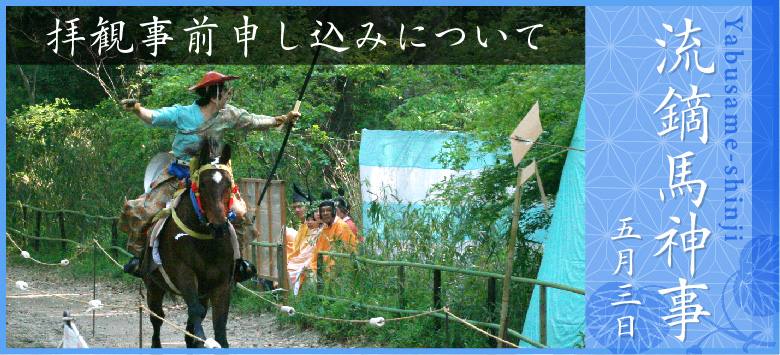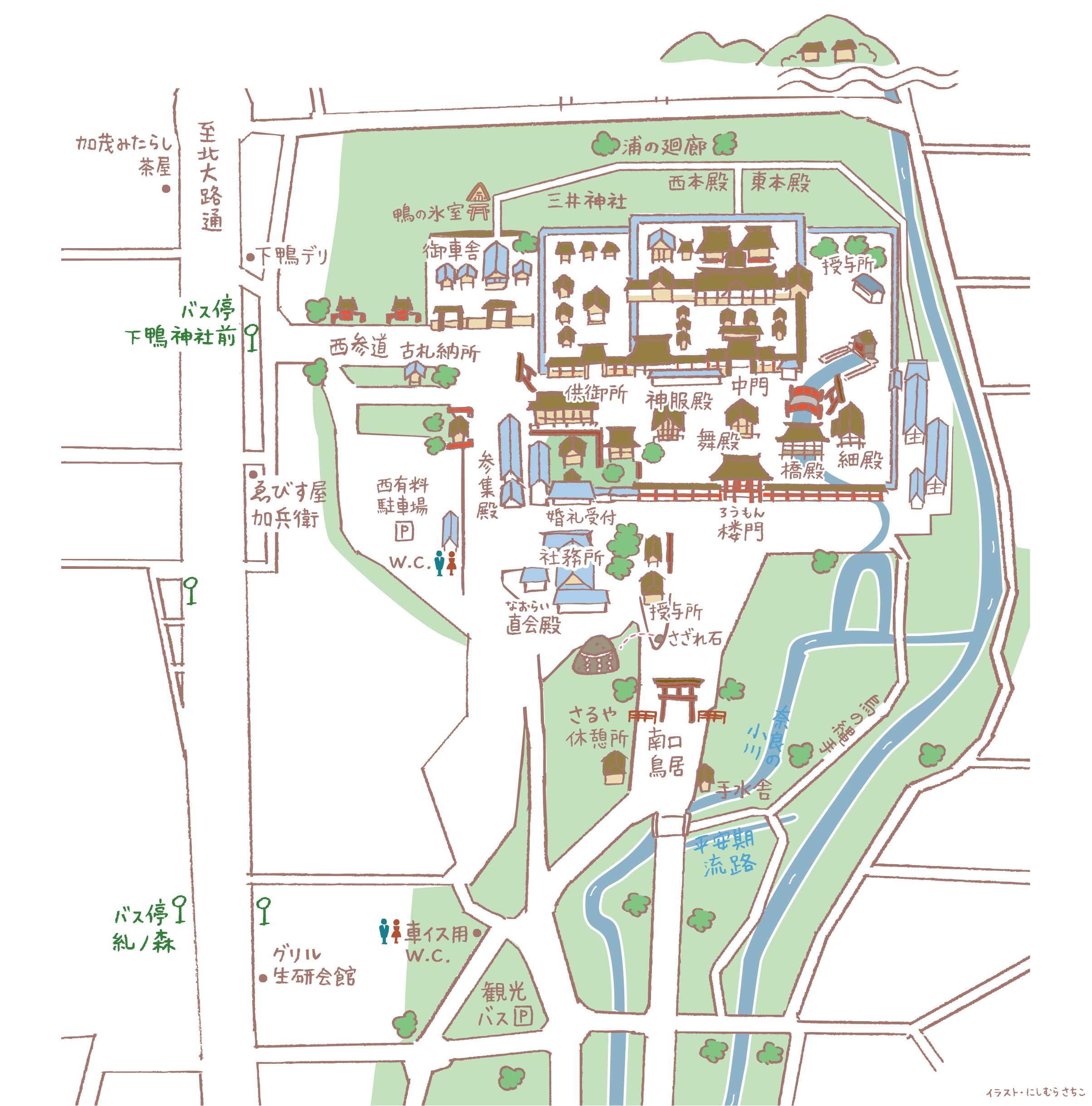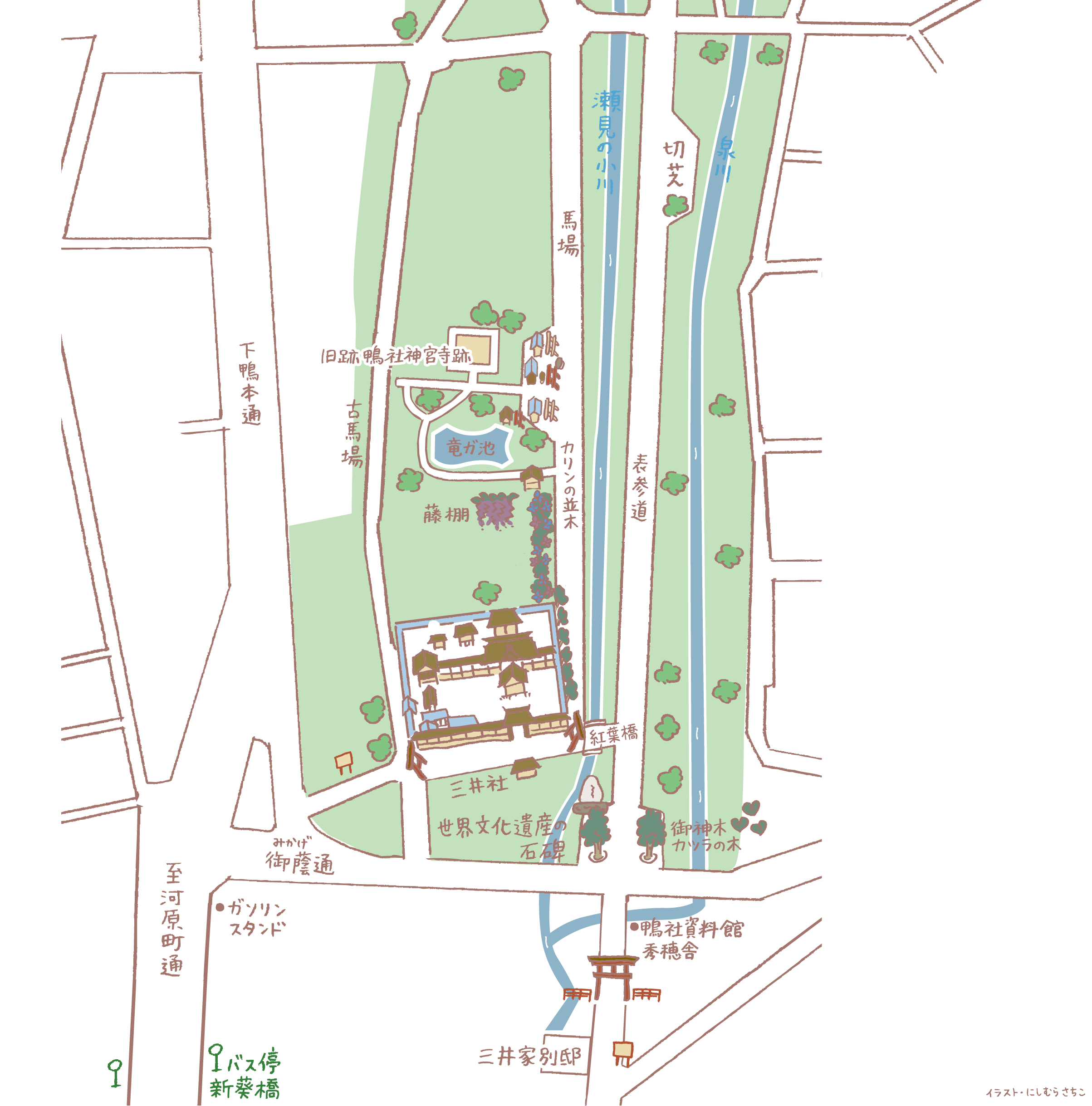Wedding ceremony application
Weekdays: 11:00am - 4:00pm Saturdays, Sundays and holidays: 10:00am - 4:00pm Phone reception: 0120-480-451

Temple grounds map
Temple grounds map
1
West main hall

Deity: Kamo Taketsunumi no Mikoto. A god who helped Emperor Jimmu. He is said to have been incarnated as a golden hawk or a Yatagarasu. He is said to grant blessings for new beginnings, protection from misfortune, and good fortune.
2
East Main Hall

Deity: Tamayorihime-no-mikoto. She is the child deity of Kamo Taketsunumi-no-mikoto and the mother deity who gave birth to the deity of Kamigamo Shrine. She is said to grant blessings for safe childbirth and child-rearing.
3
Hitokotosha

Deity: Ookunitama-no-Kami
4
Hitokotosha

Deity: Utsukunitama-no-kami
5
Futakotosha

Deity: Omononushi no Kami
6
Futakotosha

Deity: Okuninushi-no-Kami
7
Mikotosha Shrine

Deity: Shikono-no-kami
8
Mikotosha Shrine

Deity: Oonamuchi no Kami
9
Mikotosha Shrine

Deity: Yachihokonokami
3–9
Kotosha

The seven shrines are dedicated to the gods that protect the zodiac signs (the twelve signs of the Chinese zodiac). As they are the guardian deities of each person, please visit the shrine that corresponds to the year of your birth.
10
Insha

Deity: Reiji
11
Mitsui Shrine

Deity: Kamotaketsunumi-no-Mikoto
12
Mitsui Shrine

Deity: Iga Koyahime-no-Mikoto
13
Mitsui Shrine

Deity: Tamayorihime no Mikoto
14
Suwasha Shrine

Deity: Takeminakata no Kami
15
Komorisha

Deity: Mikumari no Kami
16
Shirahigesha Shrine

Deity: Sarutahiko-no-kami
17
Inoue Shrine

Deity: Seoritsuhime-no-Mikoto. Also known as Mitarashi-sha. Built on top of a well, this shrine is dedicated to the god of protection from disasters and misfortunes.
17
Mitarai Pond

This is the pond where the Saio-dai Misogi no Gi ritual, in which the heroine of the Aoi Festival, purifies herself by dipping her hands in the pond, takes place. The Foot-Soaking Ceremony on the summer day of the Doyo no Ushi also takes place here. It is said that the Mitarashi Dango (a type of sweet rice cake) originated from the bubbles that bubble up in this pond.
18
Innosha

Deity: Inji-no-Okami, Kura-Inatama-no-Kami
19
OtagiShrine, InariShrine

Deity: Homusubi no Kami
20
Izumoino Shrine
(Izumo Inohe Shrine)

Enshrined deity: Takehayasu Susanoo no Mikoto. Trees are planted with a wish in mind, and when the wish is fulfilled the leaves become jagged like holly leaves, so the shrine is commonly known as Hiragi Shrine (Holy Shrine).
21
Iwamotosha Headquarters

Deity: Sumiyoshi-no-kami
22
Hashimotosha

Deity: Tamatsushima-no-kami
23
Haraisha Shrine

Deities: Kamo Taketsunumi no Mikoto, Tamayorihime no Mikoto, Haraedo no Kami
24
Aioisha

Deity: Kamimusubi no Kami. A god of relationships between men and women and various other types of matchmaking. There are "Enmusubi Ema" plaques and "Matchmaking Omikuji" fortune-telling slips based on the Tale of Genji.
24
The Wise Tree of Love

This mysterious tree is said to be a symbol of love because it is made up of two trees that are joined together halfway through.
25
Saio Shinrei Shrine
(Saio Shinreisha)

Deity: Spirits of the successive Saio
26
Sawataya

Deity: Kantama-no-Mikoto The shrine enshrines Kantama-no-Mikoto, the god of ball sports. The first rugby match in the Kansai region was held here, so there is a monument marking the spot as the "first place for rugby."
27
Twenty-two shrines
(22nd person)

Deity: The Founding God of the Twenty-Two Kamo Clan Lines
28
Kawasaki Shrine

Deities worshipped: Oinokinomikoto, Kantama-no-Mikoto, Kamotaketsunumi-no-Mikoto, Tamayorihiko-no-Mikoto, Oyanase-no-Mikoto, and Umanoki-no-Mikoto.
29
Kawai Shrine

Deity: Tamayorihime-no-Mikoto, the beautiful deity who protects women. Imagine your face on the "Kagami Ema" and put on makeup with your wish in mind.
30
Kifune Shrine

Deity: Takaokami-no-kami
31
Tobesha Shrine

Deity: Kamo Taketsunumi no Mikoto
A god who helped Emperor Jimmu. A god of protection from misfortune and good fortune.
32
Mutsuno Shrine

(From the north)
Suwa Shrine / Deity: Takeminakata no Kami Michi Shrine / Deity: Yachimatahiko no Kami and Yachimatahime no Kami Inari Shrine / Deity: Uka no Mitama no Kami Kamado no Kami / Deity: Okutsuhiko no Kami and Okutsuhime no Kami Insha / Deity: Reiji Yuki Shrine / Deity: Sukunahikona no Mikoto
33
Mitsui Shrine

Deities worshipped: Kamo Taketsunumi no Mikoto, Iga Koyahime no Mikoto, Tamayorihime no Mikoto
34
Mikage Shrine
Enshrined on Mount Mikage

We enshrine the main deity, Aramitama (a newly born, fierce and powerful divine spirit like a baby).
35
Kamo no Chomei's residence

Kamo no Chomei, author of the "Hojoki" (Records of the Dead), was born as the son of a priest at Kawai Shrine. The hermitage where Chomei lived is restored and on display.
36
Tadasu Forest

The forest covers an area of 124,000 square meters. A clear stream flows through the forest, and the forest retains its wilderness appearance. In mid-August, a used book festival is held. "Kirishiba" in the middle of the forest has been a ritual site since ancient times.
37
Saruya

This is a reproduction of the "Shinmochi" rice cakes of the Aoi Festival, which were popular until the beginning of the Meiji period.
38
Korin's Plum Blossoms

This is the plum tree that was the model for the "Red and White Plum Blossoms Screen" painted by artist Ogata Korin.
39
Prayer Hall [Kamosha Reiden]
(Kitou
[Kamosharaiden]

We accept requests for prayers such as the first shrine visit of the year, prayers for safe childbirth, and warding off evil spirits.
40
Corridor of the Bay

You can also visit the main hall from behind through the corridor that runs around the back. This corridor has been used since ancient times to worship the main shrine from all four sides, but it was removed during the war and restored for the 34th Shikinen Sengu Ceremony.
41
Duck ice house

It was established in the Oido Hall to cook offerings for annual festivals. In ancient times, spring water from Tadasu-no-Mori Forest was drawn from deep underground, frozen during the winter, and stored in a refrigerator for use.
42
Aoi Garden
(Special viewing)

The two-leafed hollyhock, which is essential to the Aoi Festival, grows wild here. The two-leafed hollyhock is the sacred crest of Shimogamo Shrine, and during the Kamo Festival (Aoi Festival), volunteers wear it along with the Katsura. Aoi can also be written as "Afui," with "Afu" meaning to meet and "Hi" meaning spirit. It means meeting the power of the great god.
43
Oidono
(Special viewing)

God's Kitchen. This is the place where offerings to the gods are displayed.
44
Pebbles

This is the "pebbles" mentioned in the national anthem "Kimigayo."
45
Baba

As a preliminary ritual to the Aoi Festival, the Kisha Yabusame Shinji (horseback archery ritual) is held every year on May 3rd.
46
Kamo Shrine Museum Hidehosha
(Special viewing)

Materials related to the shrine are on display.
47
Former site of Jinguji Temple (special viewing)

This is the remains of a temple that was located within Shimogamo Shrine.
48
Shrine office

Please contact us if you have any questions about visiting the temple or if you would like to borrow a wheelchair.






